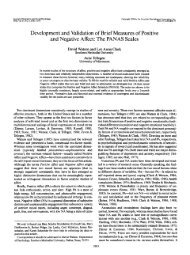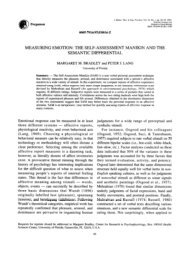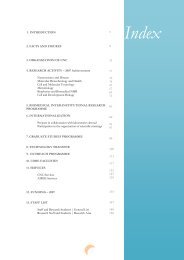Annual Report of Activities CNC 2008 - Center for Neuroscience and ...
Annual Report of Activities CNC 2008 - Center for Neuroscience and ...
Annual Report of Activities CNC 2008 - Center for Neuroscience and ...
You also want an ePaper? Increase the reach of your titles
YUMPU automatically turns print PDFs into web optimized ePapers that Google loves.
Cellular Immunology <strong>and</strong> Oncobiology | Head: Maria Celeste LopesObjectivesThe researchers <strong>of</strong> the cellular immunology <strong>and</strong>oncobiology group share common interests inidentifying the cellular mechanisms that regulate thefunction <strong>of</strong> normal human cells <strong>and</strong> inunderst<strong>and</strong>ing how disruption <strong>of</strong> these processesleads to disease, namely to allergic contactdermatitis, osteoarthritis, autoimmunity <strong>and</strong> cancer.One <strong>of</strong> the strengths <strong>of</strong> this group is the variety <strong>of</strong>approaches, ranging from in vitro studies inhuman primary cell cultures <strong>and</strong> established celllines, to in vivo experiments with animal models<strong>and</strong> analysis <strong>of</strong> clinical samples made in closecollaboration with hospital clinical units, namelywith the: i) Dermatology Department <strong>of</strong> theUniversity Hospital <strong>of</strong> Coimbra (HUC); ii)Orthopaedic <strong>and</strong> Bone Bank Departments <strong>of</strong> HUC;iii) Clinical Hematology Department <strong>of</strong> HUC; iv)Portuguese Oncology Institute <strong>of</strong> Coimbra; v)Neuropathology Laboratory <strong>and</strong> NeurosurgeryService <strong>of</strong> HUC <strong>and</strong> vi) <strong>Center</strong> <strong>for</strong> Cancer Research<strong>of</strong> the Salamanca University, Spain.Research on cellular immunology focused in:i) how different maturation stimuli, namely contactsensitizers, irritants, an endotoxin <strong>and</strong> the parasiteLeismania infantum, modulate the expression <strong>of</strong>dendritic cell (DC) surface molecules (chemokine <strong>and</strong>cytokine receptors), cytokine production <strong>and</strong> transcriptionfactors activation; ii) identifying defective processesinvolved in chondrocyte susceptibility to highglucose‐induced cell damage, thus contributing tothe development <strong>and</strong>/or progression <strong>of</strong> OA; iii) therole <strong>of</strong> the CD38 on the regulation <strong>of</strong> immuneresponses, namely infection <strong>and</strong> autoimmunity.Research on oncobiology focused in:i) molecular changes relevant to the thyroid, breast<strong>and</strong> cervical carcinogenesis; ii) the involvement <strong>of</strong>oxidative stress <strong>and</strong> cell signalling in haematologicalneoplasias <strong>and</strong> chemoresistance <strong>and</strong> its implicationson the therapeutic approach; iii) chromosomal <strong>and</strong>genetic abnormalities <strong>of</strong> human gliomas <strong>and</strong> cellsignalling pathways involved in tumour progression<strong>and</strong> migration.Main AchievementsCellular Immunology:Effects <strong>of</strong> maturation stimuli on dendritic cell (DC)protein expression: LPS increases the expression <strong>of</strong> costimulatoryproteins <strong>and</strong> cytokines/chemokines inDC. Th2 cytokine production induced by LPS isdependent on NF‐kB <strong>and</strong> ERK activation, beingnegatively modulated by p38 MAPK. The contact <strong>of</strong>virulent L. infantum parasites with DC activates AKT<strong>and</strong> ERK1/2, but was unable to fully activate DCs, asdemonstrated by low expression <strong>of</strong> cell surface costimulatorymarkers <strong>and</strong> MHC molecules.Modulation <strong>of</strong> chondrocyte functions by metabolicstimuli: unlike normal counterparts, OA humanchondrocytes under hyperglycemia are unable toadjust glucose transport <strong>and</strong> undergo oxidativestress. OA chondrocytes express functional insulinreceptors, while showing IGFR resistance.Role <strong>of</strong> CD38 in immune function: using CD38KOmice, we found that CD38 is required <strong>for</strong> effectivemacrophage activation by T cells, NO production,chemotaxis <strong>and</strong> chemokine secretion duringimmune responses against mycobacteria; <strong>and</strong> <strong>for</strong>the control <strong>of</strong> systemic autoimmunity.Oncobiology:Pathways involved in thyroid <strong>and</strong> cervical cancer:we unravelled a new pathway involved in nonmedullarythyroid cancer involving LRP1B <strong>and</strong>Wnt; identified <strong>and</strong> characterized a new probablehighrisk HPV (HPV108); <strong>and</strong> identified changes indefensins associated with increased susceptibilityto HPV infection <strong>and</strong> cervical cancer.Cell signalling pathways involved in cancer <strong>and</strong>chemoresistance: we found a decrease in antioxidantdefences <strong>and</strong> an increase in peroxides <strong>for</strong>mation,which decreases at relapse. In cells resistant toazaguanine, occurs a decrease in the expression <strong>of</strong>pro‐apoptotic proteins.Genomic <strong>and</strong> phenotypic abnormalities <strong>of</strong> humangliomas: The results show genetic heterogeneity amonghuman gliomas <strong>and</strong> support the existence <strong>of</strong> differentcytogenetic pathways <strong>of</strong> intratumoral evolution in highversus low grade tumours, which could explain theirdifferent histopathological behaviour.79






